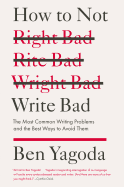
Most people are never going to write well, argues Ben Yagoda (When You Catch an Adjective, Kill It), and that's okay. But they need advice on how to avoid writing badly: how to produce prose that makes its point and doesn't confuse or annoy the reader. The average e-mail, cover letter or annual report doesn't need to be a masterpiece of literature--but it does need to be organized, concise and free of bothersome spelling, formatting, grammar and word choice errors. With How to Not Write Bad, Yagoda heads straight for the errors that native users of American English are most likely to make and the easiest ways to correct or prevent them, focusing on producing the not-bad and letting the good take care of itself.
Skipping many of the technical subjects common to writing handbooks, Yagoda concentrates on providing guidelines for formatting (stick to house style), punctuation (less is often more), spelling (use your dictionary) and word choice (ditto). He recognizes that, for most high school and college writing students, writing well is neither necessary nor of interest; they just need to know how to communicate in sentences that aren't confusing, nonsensical or woefully misspelled. His advice is short, well-organized and fun to read. This, of course, increases the chances that students of writing will actually use it--and readers everywhere can breathe a sigh of relief. --Dani Alexis Ryskamp, blogger at The Book Cricket

